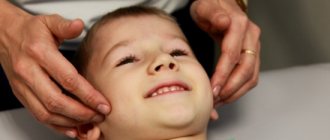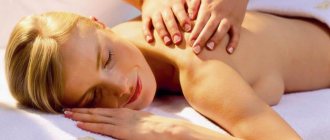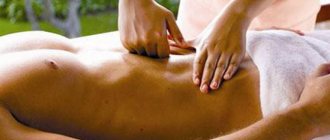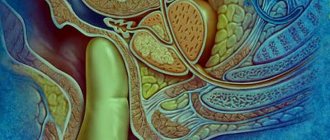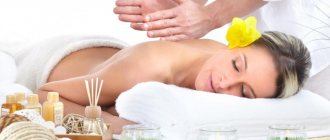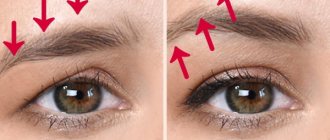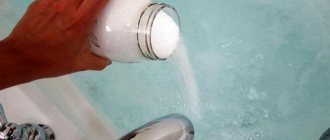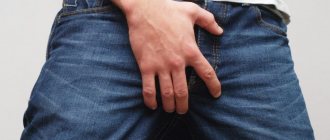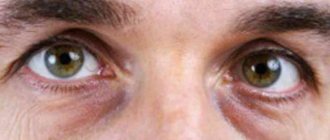Massage technique for spastic and flaccid paralysis[edit | edit code]
In diseases of the nervous system, movement disorders can be observed: paralysis, paresis, hyperkinesis.
Paralysis
- this is the complete absence of muscle contraction;
paresis
is a partial impairment of motor function. There are two types of paralysis and paresis: spastic and flaccid. With spastic paralysis (it occurs when the cortex of the anterior central gyrus or pyramidal tract in the brain is damaged), voluntary movements are absent, muscle tone increases and all tendon reflexes are enhanced. Flaccid paralysis develops when the peripheral nerves, roots or gray matter of the spinal cord are damaged. It is characterized by the absence of both voluntary and involuntary movements, tendon reflexes, low muscle tone and atrophy. To restore movements, reduce spasticity and eliminate synkinesis (involuntary movements) in the early stages of the disease, massage is prescribed in combination with passive movements of paralyzed limbs.
In all cases of illness, the massage therapist determines the massage session technique individually for each patient. However, there is a general rule that must be followed in any massage session.
Massage for spastic paralysis[edit | edit code]
The purpose of the massage is, first of all, to relieve tension in the neuromuscular system, that is, to reduce muscle tone. The massage session is carried out with the patient lying on his stomach, and the shins should be raised and lying on a roller, which helps to relax not only the spastic muscles, but also the whole body.
The massage session begins from the back. The pelvis and legs should be covered with something warm (blanket, blanket) - the heat will be retained, and this will promote additional relaxation.
First, do a combined stroking over the entire back, strictly from the iliac crest to the neck (10-12 times), then a light squeeze with the edge of the palm over the entire back (5-6 times), a double ring on the latissimus dorsi muscles (2-4 times on each side), combined stroking (5 - 7 times). And then they stroke the neck: from the top of the head down to the shoulder joints (3 - 4 times). The complex is repeated 3 times and moved to the pelvic area (cover the back with something warm).
Use longitudinal alternating stroking (7 - 10 times), light squeezing with the edge of the palm (3 - 5 times), double circular kneading (3 - 4 times), shaking (3 - 4 times), longitudinal alternating stroking (5 - 7 times). The complex is repeated 3-4 times and the other side of the pelvis is massaged using the same technique.
On the back of the thigh, combined stroking (8-10 times), transverse squeezing (3-5 times), shaking (3-4 times), vibration with the whole hand is used, performed in three to four sections in the direction from the knee joint up to the pelvic area (2 - 3 times), stroking (5 - 7 times), double circular kneading (very light) and longitudinal (2-4 times), shaking (3 - 4 times), combined stroking (3 - 5 times). Repeat the whole complex 2 - 3 times. Over time, the number of repetitions can be increased up to 6 times.
The second thigh is massaged using the same technique.
The calf muscle is massaged in the position of a raised limb lying on a roller (i.e., in the most physiologically comfortable position). The session begins with combined stroking (7-10 times), then the massage therapist stands longitudinally in relation to the patient, takes the ankle joint with his far hand, lifting the shin at an angle of 35-45°, and performs longitudinal squeezing (4-5 times), shaking (3 - 4 times), alternating longitudinal stroking (3 - 4 times). Then performs light ordinary kneading (4 - 5 times), longitudinal spiral stroking (4 - 5 times), squeezing (3 - 4 times), shaking and stroking (3 - 5 times). The second calf muscle is also massaged.
Before starting to massage the front of the thigh and lower leg, it is necessary to carry out combined stroking on the back (4 - 7 times), and on the gluteal muscles - longitudinal alternating (4 - 7 times).
Massage of the front part of the thigh is performed in a position where the patient’s head lies on a cushion (pillow); there is also a roller under the knee joints, but of a smaller diameter. Combined stroking is used (7 - 9 times). Subsequent techniques are carried out in the position of the massaged person sitting, hands resting behind: squeezing with the edge of the palm (3 - 5 times), shaking (3 - 5 times), ordinary kneading (3 - 5 times), shaking (3 - 4 times), squeezing ( 3 - 4 times), longitudinal kneading (3 - 4 times), shaking and stroking (4 - 6 times), vibration for 5 s in three to four places. The complex is repeated 2 - 4 times and moves on to the anterior tibial muscles.
After combined stroking (5 - 7 times), transverse squeezing (3 - 4 times), kneading with the edge of the palm (3 - 4 times), combined stroking (5 - 7 times), kneading with the base of the palm (4 - 5 times), combined stroking (5 - 7 times). The whole complex is repeated 2 - 4 times.
Practice has shown that with spastic paralysis and synkinesis, you can achieve a good result if you use a pair massage: one massage therapist massages one thigh and lower leg, the other at the same time massages the other thigh and lower leg.
A couples massage session can be performed under the dictation of one of the massage therapists. In this case, he is the leader, and another massage therapist duplicates him. Deviation from synchronous execution is allowed, but no more than one repetition of the technique: so, if one massage therapist performed the technique 4 times, the second performs it for the third time. When conducting a couples massage, it is advisable to select massage therapists with identical physiological qualities, i.e. with warm (cold), dry (wet), soft (hard) hands, and most importantly - equally proficient in the technique and methodology of massage techniques.
Before starting a couples massage for spastic paralysis, massage therapists must work out a model of the massage session technique and only after several rehearsals on a healthy person (or a dummy) begin massaging the patient.
The duration of a couples massage session should be 30-50% shorter than usual.
After the muscles have been thoroughly and deeply worked through massage, you can begin passive movements in the knee, hip and ankle joints.
Passive movements are carried out synchronously with both affected arms or legs (or affected and healthy) at the same pace, direction and with the same strength dosage. It is more convenient to perform them with the help of another massage therapist or another person. The movements are carried out at a slow pace, they should not cause fatigue, and they can be performed 3 - 4 times a day. After 2 - 3 movements, do a combined stroking and shaking.
In case of spastic paralysis, as movements are restored, the patient should help himself with self-massage, using the ability to independently relax the muscles. For example, if spasticity occurs in both legs while standing up, you need to lean on your hands (on crutches or holding the headboard of the bed with your hands), bend in the lumbar spine or perform circular movements with your torso. The starting position, dosage, and pace of exercises that promote maximum muscle relaxation are selected individually. To reduce the tone of large muscles, swing movements with a gradual increase in amplitude and shaking of the limb are used, as well as “rolling” the foot and hand on a rotating roller.
Massage for flaccid paresis and paralysis[edit | edit code]
These disorders are characterized by deeper functional disorders of the motor system than spastic paralysis.
For flaccid paralysis, a deep and moderately hard massage is performed. The objectives of massage for flaccid paralysis: improve blood and lymph circulation, reduce pain, help accelerate the regeneration processes of affected nerve fibers, strengthen paretic muscles, counteract the formation of contractures and deformities, increase muscle tone and strength, reduce their atrophy, promote the restoration of movements, improve health and strengthen general condition of the patient.
The massage technique is based on the characteristics of the clinical form of the lesion. It is very important that the massage therapist be able to identify the presence of paresis, paralysis and their degree (although this is determined by the doctor), since without knowing which muscles or their bundles are affected, it is impossible to perform a massage correctly and differentiatedly.
For various diseases accompanied by flaccid paralysis, massage should be aimed not only at strengthening weakened muscles, but also at relaxing antagonist muscles.
Practice has shown that the best results in the treatment of flaccid paralysis can be expected in cases where couples massage is used.
A couples massage session begins from the back. The patient lies on his stomach, arms are located along the body, legs are on the bolster. After longitudinal alternating stroking (3 - 4 times), they begin longitudinal squeezing (6 - 8 times), kneading on the long back muscles with the base of the palms of both hands (7 - 10 times). On the broadest muscles, perform a double circular kneading (5 - 7 times), then shaking (2 - 3 times), squeezing with the edge of the palm (6 - 8 times), on the long muscles, kneading with the phalanges of the fingers bent into a fist (5 - 7 times) , on the latissimus muscles - double ring and “double bar” (5 - 7 times), shaking and stroking (3 - 4 times). The complex is repeated 2 - 3 times. The same is done on the other side of the back.
Massage in the pelvic area begins with longitudinal alternating stroking (3 - 4 times), then longitudinal squeezing in three to four lines (5 - 7 times), double circular kneading (5 - 7 times), shaking (2 - 3 times), " double bar" (8-10 times), squeezing (4-6 times), stroking and shaking (2-3 times).
Rubbing is performed on the hip joint, sacrum and along the iliac crest. After this, the second side of the pelvis is massaged.
If both limbs are affected, the massage can be started from any thigh, and if one limb is sick, then the procedure begins with the healthy one, usually from its back surface (although this is not necessary).
Apply longitudinal alternating stroking (3 - 4 times), squeezing with the edge of the palm (6 - 8 times), double circular kneading (8 - 10 times), shaking and stroking (2 - 3 times), "double bar" (4 - 6 times), squeezing (4 - 5 times), shaking, stroking (2 - 3 times). Then perform longitudinal kneading (4 - 6 times), chopping, which is carried out both across the muscle fibers and along (3-4 times), double circular kneading (3 - 5 times), kneading with fists (3 - 5 times), shaking and stroking (2 - 3 times).
In the first three sessions, you can limit yourself to one series of techniques. Subsequently, they are repeated 2-3 times, depending on the patient’s condition.
The same techniques are performed on the affected limb, but more easily at first. The impact can be gradually enhanced by increasing the number of repetitions of techniques, as well as by increasing the number of different techniques, using, for example, double ring kneading, the bases of the palms, fists, phalanges of fingers bent into a fist, “double bar,” rubbing the thigh fascia, effleurage , chopping.
When massaging the knee joint, place a cushion under the foot; this position helps to relax the ligaments of the joint. Start with concentric stroking. It is not always performed with the same pressure on the joint area. At that moment, when the hands slide up to the thigh, the hands seem to squeeze something out of the joint; Having reached the lower third of the thigh, the hands relax and easily slide to the lower leg. At the same time, blood and lymph flow increases not only in the area of the knee joint, but also in the lower leg. At the same time, the lateral ligaments of the joint are prepared for a deeper massage - rubbing.
All possible types of rubbing are performed on the joint. After thoroughly working out the knee joint (it is better when it is massaged from the back and front sides), they begin to perform passive and active movements with resistance. Particular attention is paid to the places where the muscles attach to the tendons, the places around the heads of the fibula and tibia, as well as the condyles of the femur.
When massaging the calf muscle of a healthy limb, the following techniques are performed: combined stroking (2 - 3 times), longitudinal squeezing (4 - 6 times), ordinary kneading (6 - 8 times), shaking (2 - 3 times), kneading with phalanges of bent fingers into a fist (4 - 6 times), with the base of the palm (3 - 4 times), shaking and stroking (2 - 3 times). A roller is placed under the shin and more stringent techniques are performed: double bar kneading (3 - 5 times), double ring kneading (5 - 6 times). Then a combined stroking is done to relieve the tension that has arisen from the muscle. Shaking also performs the same function. The complex of squeezing and kneading techniques can include shock techniques that cause nerve impulses that stimulate the muscular system.
The second calf muscle is massaged using the same technique.
In the same position, the calcaneal tendon, heel and sole of the foot are massaged. Thigh massage is possible in two initial patient positions.
First position. The patient sits with his arms supported behind him. The legs are stretched along the couch.
In this position, the following techniques are used: combined stroking (2-3 times), transverse squeezing (6-8 times) (remember that the massage should be carried out on the internal, middle and external areas), ordinary kneading (3-5 times), “ double bar" (5 - 7 times), shaking (3 - 4 times), squeezing with the edge of the palm (4 - 6 times), double ring (5 - 7 times). Then the fascia of the outer thigh is rubbed (4 - 6 times), shaken (3 - 4 times), double circular kneading (5 - 7 times), kneading with fists (4 - 6 times), shaking and stroking (2 - 3 times). ).
Second position. The patient lies on his back. The massage therapist places his nearest knee on the couch and places the patient's leg on his thigh. The following techniques are used: longitudinal alternating stroking (3 - 4 times), longitudinal squeezing with the base of the palm and the tubercle of the thumb (6 - 8 times), ordinary kneading (6 - 8 times), shaking (2 - 3 times), double ordinary kneading (5 - 8 times), stroking (3 - 4 times), kneading with phalanges of fingers bent into a fist (4 - 6 times), felting (4 - 6 times), kneading with the pad of the thumb (4 - 6 times), stroking (3 - 4 times), double ordinary kneading (6 - 8 times), squeezing (4 - 5 times), stroking (2 - 3 times). The whole complex is repeated 3 - 4 times.
Massage of the knee joint is carried out using all rubbing techniques.
When massaging the lower leg (anterior tibial muscles), the patient can be in the following starting positions.
First position. The patient lies on his back, leg extended. Perform combined stroking (3 - 4 times), squeezing with the edge of the palm (6 - 8 times), kneading with the edge of the palm (5 - 7 times), kneading with the phalanges of the fingers bent into a fist (4 - 6 times), transverse squeezing (4 - 5 times ), stroking (2 - 3 times).
Second position. The person being massaged lies on his back, his leg is moved to the side and is fixed with an emphasis on the masseur’s thigh of the same name, who stands longitudinally at the level of his feet. In this position, the massage is carried out according to the following method: longitudinal alternating stroking (3 - 4 times), longitudinal squeezing with one hand or with weights (6 - 8 times), kneading with the pad of the thumb (4 - 6 times), alternating stroking (2 - 3 times), kneading the phalanges of the fingers of one hand, bent into a fist, and with weights (5 - 7 times), the base of the palm (4 - 6 times). Finish with stroking (4 - 5 times). The entire complex is repeated 2-3 times, gradually the number of repetitions can be increased.
Third position. The person being massaged lies on his back, the leg is bent at the hip and knee joints, the massage therapist sits at the level of the patient’s feet and fixes the patient’s knee joint with his hand.
The massage is carried out according to the following technique: longitudinal alternating stroking (3 - 4 times), longitudinal squeezing (5 - 7 times), kneading with the edge of the palm (5 - 7 times), stroking (2 - 3 times), squeezing with the edge of the palm (4 - 6 times), kneading with the pad of the thumb (5-7 times) and the edge of the palm (2-5 times), stroking (2-3 times), kneading with the phalanges of the fingers bent into a fist (4-5 times). Finish with stroking. The complex is repeated 4 - 6 times.
The choice of complex is carried out at the request of the massage therapist. They can be alternated.
The ankle joint is massaged while lying on your back (or sitting). The back of the foot is also massaged in the same position.
The heel tendon and sole of the foot are massaged with the patient lying on his stomach, the lower leg bent at an angle of 45 - 90°. All rubbing techniques and active-passive movements are used.
For flaccid paresis or paralysis, it is very useful to carry out self-massage and gymnastics in water (swimming pool, warm bath).
PRELIMINARY DIAGNOSTICS
The appointment of speech therapy massage should be preceded by a medical diagnosis carried out by a doctor. The medical report contains an indication of the presence of neurological symptoms, including an indication of the form of paresis (or paralysis), local disorders of muscle innervation, etc. As a rule, speech therapy massage is recommended only on the recommendation of a doctor. Before starting correctional work, the speech therapist must determine the form and structure of the speech defect, guided by the clinical and pedagogical classification, and then raise the question of the need for massage. As a rule, the main indication for massage is a change in muscle tone, which can be observed both in the general muscles and in the organs of the speech apparatus. However, even with a medical report, the speech therapist must independently diagnose the condition of the muscles. This will help him determine massage tactics in each specific case. The speech therapist should determine the condition of the muscles: the upper half of the torso, neck, facial expression, articulation. This is established by inspection, palpation, and observation when performing dynamic and static exercises.
Inspection. When examining a child, you should pay attention to the position of the head in relation to the body, and note whether there are any habitual asymmetrical postures. When examining the face, one must remember about possible asymmetry in the form of a smoothed nasolabial fold, drooping corner of the mouth, widened or narrowed palpebral fissure, as well as the presence of a constantly slightly open mouth, drooling (this is important). Skin coloration, skin rashes, skin hemorrhages.
Palpation. Palpation of the muscles involved in articulation allows the speech therapist to more accurately determine the nature of muscle tone disorders. The following characteristics are determined by palpation. Skin elasticity, skin swelling, condition of lymph nodes, condition of muscles.
Types of massage used in speech therapy practice
Several types of massage can be used in speech therapy practice. The main thing is differentiated (strengthening or relaxing) massage, based on the techniques of classical (manual) massage. In addition, speech therapy practice uses massage of biologically active points (BAP), massage using special devices (speech therapy probe, spatula, vibrating massager, cupping, etc.), as well as elements of self-massage.
Contraindications for massage
Contraindications for massage are any somatic or infectious disease in the acute period, conjunctivitis, acute and chronic skin diseases, gingivitis, stomatitis, the presence of herpes on the lips or other infections of the oral cavity, the presence of enlarged lymph glands, pronounced pulsation of the carotid arteries. Before conducting a massage course, it is necessary to obtain a conclusion from a neurologist and pediatrician about the absence of contraindications.
Preparing for a massage
To carry out a massage, the speech therapist must have the following materials: 1) medical alcohol (for disinfecting probes, spatulas. 2) sterile napkins 30 x 30 cm (for examining the state of muscle tone of the articulatory apparatus), 3) hexoral (after massaging the muscles of the oral cavity, the child can for hygiene purposes, rinse your mouth with the solution), 4) sterile medical rubber gloves (can be used when performing massage in the oral cavity), 5) ammonia and 3 percent hydrogen peroxide (can be used if necessary to provide emergency care), 6) protective mask (use it is advisable to avoid droplet infection). The skin of the person being massaged should be clean, the hands of the speech therapist should be clean and warm, without abrasions or scratches or any areas of inflammation, with short-cut nails, without jewelry that would interfere with the massage. Before massaging your face or neck, you can lightly lubricate your hands with baby oil or use baby powder. When massaging the muscles of the oral cavity, it is recommended to use sterile medical rubber gloves or sterile napkins.
General recommendations for massage.
Speech therapy massage is carried out in a clean, comfortable, warm and well-ventilated room. On average, two or three procedures per week, performed in a row or every other day, may be sufficient. Typically, massage is carried out in a cycle of 10 - 20 procedures. These cycles can be repeated at intervals of two weeks to two months. In case of severe disorders of muscle tone, massage can be carried out for a year or more. The duration of one procedure may vary depending on the degree of damage, the age of the patient, etc. The initial duration of the procedure is usually 5 - 7 minutes, and the final duration is 20 - 25 minutes.
Body positions during massage.
Before starting the procedure, the child must take the correct position - a resting position. Adopting the correct posture helps relax muscles, makes breathing free, and also provides a comfortable position for the speech therapist when performing a massage.
The following body positions are optimal for speech therapy massage: 1. The person being massaged lies on his back, arms extended along the body, legs lying freely, socks slightly apart. Under the head is a small flat pillow that reaches the upper edge of the shoulder blades. The speech therapist takes a position behind the patient's head. 2. Pose - half-sitting in a chair with a high headrest. The speech therapist takes a position behind the patient's head.
BASIC MASSAGE TECHNIQUES.
- Stroking: superficial; deep grasping; rake-shaped.
- Trituration.
- Kneading.
- Vibration and effleurage.
- Firm pressure
Stroking. This is a mandatory technique with which every procedure begins. It is alternated with other techniques and ends each massage complex.
Trituration. This technique is carried out, as a rule, in small, limited areas (the subcutaneous fat tissue is slightly shifted into the fold).
Kneading . This technique is performed in the same way as rubbing, in the area of individual muscle groups, maximally activating muscle function. It consists of grasping, sliding, pulling, squeezing, squeezing, pinching and rubbing tissue.
Vibration and effleurage . Vibration changes interstitial metabolism and improves tissue condition. Strong, hard vibration increases muscle tone, and light, weak vibration reduces their tone.
Press firmly . As a rule, this technique, which improves blood circulation, lymph circulation, and metabolic processes, is used at the exit points of bundles of nerve endings.
Guidelines for conducting a relaxing massage.
- The massage is performed at a slow pace.
- The main techniques are stroking and light vibration.
- A relaxing massage should cause only pleasant feelings of warmth and peace in the child.
- The speech therapist's hands must be warm.
- Muscle relaxation is facilitated by the sound of quiet music with a slow, smooth rhythm or by the speech therapist performing the massage pronouncing calm formulas for autogenic training.
- To enhance the relaxing effect, a warm compress can be placed on the face of a teenager or adult a few minutes before the massage. This can be a terry towel soaked in warm water (40-45°C) and wrung out well. The compress is applied for 3 - 5 minutes.
- The sequence of effects on the massaged areas during one relaxing massage session can be as follows:
- muscles of the neck and shoulder girdle,
- facial muscles,
- lip muscles,
- muscles of the tongue.
Methodological instructions for carrying out activating massage.
- This type of massage is used for decreased muscle tone.
- The speech therapist's hand movements should be quite rhythmic.
- The main technique is stroking, which alternates with rubbing, kneading, and strong vibration.
- The force on the massaged tissues should increase gradually.
- Vigorous effects are contraindicated on the front surface of the neck, since the thyroid gland is located in this area.
- When the massage is performed correctly, the baby's breathing is even.
- The massage should not cause significant pain in the person being massaged.
- The sequence of effects on the massaged areas during one strengthening massage session can be as follows:
- facial muscles,
- lip muscles,
- tongue muscles,
- muscles of the neck and shoulder girdle.
